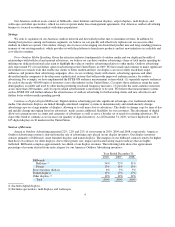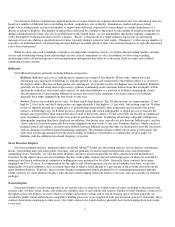iHeartMedia 2010 Annual Report Download - page 17
Download and view the complete annual report
Please find page 17 of the 2010 iHeartMedia annual report below. You can navigate through the pages in the report by either clicking on the pages listed below, or by using the keyword search tool below to find specific information within the annual report.
We face intense competition in the broadcasting and outdoor advertising industries
We operate in a highly competitive industry, and we may not be able to maintain or increase our current audience ratings and
advertising and sales revenues. Our radio stations and outdoor advertising properties compete for audiences and advertising revenues
with other radio stations and outdoor advertising companies, as well as with other media, such as newspapers, magazines, television,
direct mail, iPods, smart mobile phones, satellite radio and Internet-based media, within their respective markets. Audience ratings and
market shares are subject to change, which could have the effect of reducing our revenues in that market. Our competitors may develop
services or advertising media that are equal or superior to those we provide or that achieve greater market acceptance and brand
recognition than we achieve. It also is possible that new competitors may emerge and rapidly acquire significant market share in any of
our business segments. An increased level of competition for advertising dollars may lead to lower advertising rates as we attempt to
retain customers or may cause us to lose customers to our competitors who offer lower rates that we are unable or unwilling to match.
Our business is dependent upon the performance of on-air talent and program hosts
We employ or independently contract with many on-air personalities and hosts of syndicated radio programs with significant
loyal audiences in their respective markets. Although we have entered into long-term agreements with some of our key on-air talent
and program hosts to protect our interests in those relationships, we can give no assurance that all or any of these persons will remain
with us or will retain their audiences. Competition for these individuals is intense and many of these individuals are under no legal
obligation to remain with us. Our competitors may choose to extend offers to any of these individuals on terms which we may be
unwilling to meet. Furthermore, the popularity and audience loyalty of our key on-air talent and program hosts is highly sensitive to
rapidly changing public tastes. A loss of such popularity or audience loyalty is beyond our control and could have a material adverse
effect on our ability to attract local and/or national advertisers and on our revenue and/or ratings, and could result in increased
expenses.
Our business is dependent on our management team and other key individuals, many of whom are new to our company and one of
whom, our President and Chief Executive Officer, has announced his intention to retire
Our business is dependent upon the performance of our management team and other key individuals. A number of these
individuals, including Robert W. Pittman, the new Chairman of our Media and Entertainment Platforms pursuant to a consulting
agreement, Thomas W. Casey, our Chief Financial Officer, Scott D. Hamilton, our Chief Accounting Officer, and Robert H. Walls, Jr.,
our General Counsel, joined us in 2010, and two of our three divisional CEOs, Ronald Cooper, the Chief Executive Officer of Outdoor
Americas, and William Eccleshare, the Chief Executive Officer of Outdoor International, have joined us within the last 18 months.
Although we have entered into agreements with some of these and other individuals, we can give no assurance that all or any of our
management team or key individuals will remain with us. Competition for these individuals is intense and many of our key employees
are at-will employees who are under no legal obligation to remain with us, and may decide to leave for a variety of personal or other
reasons beyond our control.
14
•
an increased level of competition for advertising dollars, which may lead to lower advertising rates as we attempt to retain
customers or which may cause us to lose customers to our competitors who offer lower rates that we are unable or unwilling
to match;
•
unfavorable fluctuations in o
p
eratin
g
costs, which we ma
y
be unwillin
g
or unable to
p
ass throu
g
h to our customers;
•
technological changes and innovations that we are unable to adopt or are late in adopting that offer more attractive
advertising or listening alternatives than what we offer, which may lead to a loss of advertising customers or to lower
advertisin
g
rates;
•
the impact of potential new royalties charged for terrestrial radio broadcasting, which could materially increase our
ex
p
enses;
•
unfavorable shifts in population and other demographics, which may cause us to lose advertising customers as people
migrate to markets where we have a smaller presence or which may cause advertisers to be willing to pay less in advertising
fees if the
g
eneral
p
o
p
ulation shifts into a less desirable a
g
e or
g
eo
g
ra
p
hical demo
g
ra
p
hic from an advertisin
g
p
ers
p
ective;
•
unfavorable changes in labor conditions, which may impair our ability to operate or require us to spend more to retain and
attract ke
y
em
p
lo
y
ees; and
•
changes in governmental regulations and policies and actions of regulatory bodies which could restrict the advertising media
that we employ or restrict some or all of our customers that operate in regulated areas from using certain advertising media,
or from advertisin
g
at all.
























